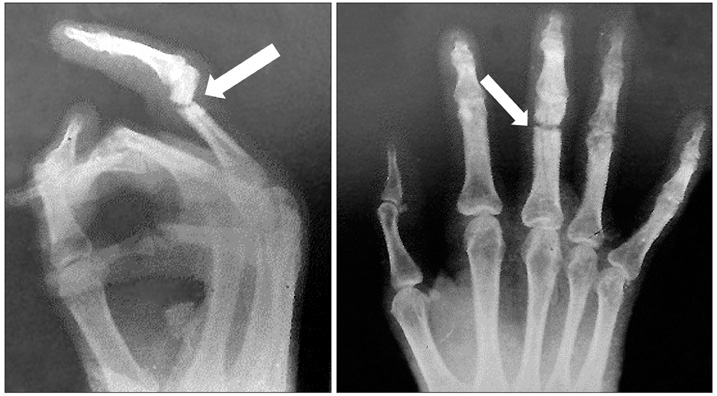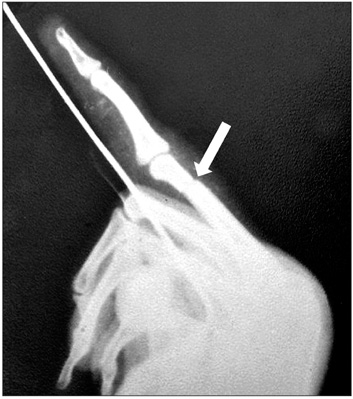Clin Orthop Surg.
2012 Jun;4(2):156-162. 10.4055/cios.2012.4.2.156.
Management of Proximal Phalangeal Fractures of the Hand Using Finger Nail Traction and a Digital Splint: A Prospective Study of 43 Cases
- Affiliations
-
- 1Hull Royal Infirmary, Hull, UK. shahjehan200@googlemail.com
- 2Government Rajaji Hospital, Madurai, India.
- 3Royal Liverpool University Hospital, Liverpool, UK.
- KMID: 1383878
- DOI: http://doi.org/10.4055/cios.2012.4.2.156
Abstract
- BACKGROUND
Proximal phalangeal fractures are common fractures of the hand. The fractures are difficult to treat because of vicinity of two important joints and crossing long tendons. The purpose of this study was to evaluate the efficacy of nail traction technique in the management of proximal phalangeal fractures of the hand.
METHODS
Patients (n=43) with proximal phalangeal fractures were treated by nail traction and evaluated prospectively. We assessed all the patients at the time of presentation and then followed a standard protocol for recruiting patients. After application of nail traction, the patients were initially assessed at 12th day. The outcome measures included post reduction radiographic evaluation and total active motion (TAM) in finger at the final follow-up appointment. All the patients were followed for one year.
RESULTS
The post-reduction X-ray evaluation showed good reduction in 33 cases, fair reduction in 8 and poor reduction in 2 cases. At final assessment, 35 patients had good TAM score, six had fair and two had poor TAM score. Complications were noted in two patients and these included pressure necrosis in palm and stiffness in proximal interphalangeal joint.
CONCLUSIONS
The results of this prospective study show that with careful selection of patients, nail traction seems to be simple, safe and effective technique for managing proximal phalangeal fractures.
Keyword
MeSH Terms
Figure
Reference
-
1. Barton NJ. Fractures of the shafts of the phalanges of the hand. Hand. 1979. 11(2):119–133.
Article2. Crick JC, Franco RS, Conners JJ. Fractures about the interphalangeal joints in children. J Orthop Trauma. 1987. 1(4):318–325.
Article3. De Jonge JJ, Kingma J, van der Lei B, Klasen HJ. Phalangeal fractures of the hand: an analysis of gender and age-related incidence and aetiology. J Hand Surg Br. 1994. 19(2):168–170.4. Butt WD. Fractures of the hand. I. Description. Can Med Assoc J. 1962. 86(16):731–735.5. Burkhalter WE, Reyes FA. Closed treatment of fractures of the hand. Bull Hosp Jt Dis Orthop Inst. 1984. 44(2):145–162.6. Capo JT, Hastings H 2nd. Metacarpal and phalangeal fractures in athletes. Clin Sports Med. 1998. 17(3):491–511.
Article7. Reyes FA, Latta LL. Conservative management of difficult phalangeal fractures. Clin Orthop Relat Res. 1987. (214):23–30.
Article8. Ryes F. Dynamic closed treatment of proximal phalanx fractures. 38th American Society for Surgery of the Hand Annual Meeting. 1983 Mar 7-9; Anaheim, CA, USA.9. Pun WK, Chow SP, So YC, et al. A prospective study on 284 digital fractures of the hand. J Hand Surg Am. 1989. 14(3):474–481.
Article10. Swanson TV, Szabo RM, Anderson DD. Open hand fractures: prognosis and classification. J Hand Surg Am. 1991. 16(1):101–107.
Article11. Maitra A, Burdett-Smith P. The conservative management of proximal phalangeal fractures of the hand in an accident and emergency department. J Hand Surg Br. 1992. 17(3):332–336.
Article12. Rajesh G, Ip WY, Chow SP, Fung BK. Dynamic treatment for proximal phalangeal fracture of the hand. J Orthop Surg (Hong Kong). 2007. 15(2):211–215.
Article13. Koul AR, Patil RK, Philip V. Traction splints: effective non-surgical way of managing proximal phalanx fractures. J Trauma. 2009. 66(6):1641–1646.
Article14. Barton NJ. Fractures of the hand. J Bone Joint Surg Br. 1984. 66(2):159–167.
Article15. Pennig D, Gausepohl T, Mader K, Wulke A. The use of minimally invasive fixation in fractures of the hand - the minifixator concept. Injury. 2000. 31:Suppl 1. 102–112.
Article16. Tubiana R. Early mobilization of fractures of the metacarpals and phalanges. Ann Chir Main. 1983. 2(4):293–297.
- Full Text Links
- Actions
-
Cited
- CITED
-
- Close
- Share
- Similar articles
-
- Distribution of Hair on the Phalanges of the Hand in Koreans
- The Usefulness of the Artificial Nail for Treatment of Fingertip Injuries
- External Dynamic Traction Device for Fracture of the Proximal Interphalangeal Joint of the Finger
- Treatment of Phalangeal Joint Stiffness Related to Proximal Phalangeal Bone Fractures: Therapeutic Effects on the Range of Motion and Finger Pain
- Controlled active exercise after open reduction and internal fixation of hand fractures





